




Introduction to Time
Time seen through an analogue clock or a digit clock has to be understood correctly. For the first instance, children find it difficult to understand time. Two prime reasons for the difficulty in understanding time are that the time is the same two times in a day, and the unit of time is made of 60 units, unlike other units of 10 or 100 units.
Adding to this challenge are two-time formats for math, a 12-hour format and a 24-hour format. Time has units of hours, minutes, and seconds and is expressed in AM (Anti Meridian) or PM (Post Meridian). Further, let us check the below content to know more about reading time by looking at the hands of the clock.
What are Clocks?
A clock normally displayed in a room or connected to a wall displays the time. You can see clocks of different sizes around you. Some clocks show only time, whereas others show temperature, date, weather, etc. Also, some clocks have a stopwatch, and some have alarms.
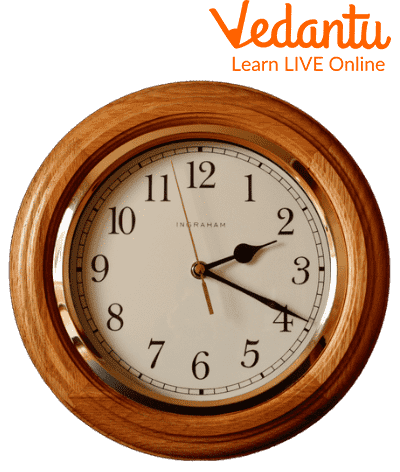
The Clock
Parts of Clock
The two widely used clocks are the analogue and digital clocks. Both clocks have different ways of representing time.
What are Analogue Clocks?
A clock is known as an analogue clock when it has moving hands and is usually (hours) marked from 1 to 12 to show you the time of the day.
In some analogue clocks, hours are marked with Roman numerals (such as I, II, III, IV, etc.), while in others, no numbers are marked in the clock.
Minute Hand
The hand on a clock or watch that displays the minutes is called a minute hand; it is typically longer than the hour hand. The large hand indicates the minutes on a clock. It completes one full circle every 60 minutes (one hour). For instance, the minute hand is just past the number " 4 " on the clock on the left, and by counting the small markers starting at " 12," you can see that it is 22 minutes past the hour. (The "hour hand" on the little hand is barely past eight, making the time 22 past eight).
Hour Hand and Minute Hand
Following is the difference between the hour hand and the minute hand:
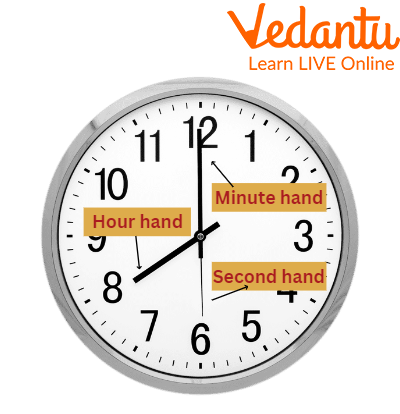
Hour hand and Minute hand
What are Digital Clocks?
Digital clocks are one of our society's most common pieces of technology. The electronic wristwatch has experienced major evolutionary changes and dozens of offshoots, including everything you could imagine cramming into a wristwatch.
Uses of Clocks
Following are the uses of the clocks:
A watch is a device used to measure, verify, keep, and indicate the time.
A clock is one of the oldest human inventions, which meets the need to measure shorter time intervals than natural units like the day, the lunar month, and the year.
It helps to maintain discipline among the people.
Solved Example
Q 1. Ram and Shyam are playing the game "Clock". Ram must check the time on the provided clock. When he saw the clock, what time should he say?
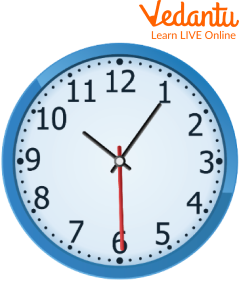
Time
Ans: The hour hand is at 10, indicating 10 hours. The minute hand is at 1. Let's calculate minutes: 1 × 5= 5. Therefore, the time is 10:05.
Q 2. Ram is given two photos of clocks. He needs to locate the clock that reads 10:45. Which clock should he pick from the list below?
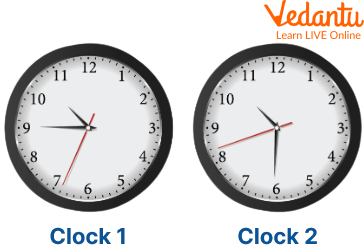
Different clocks
Ans: The hour hand of the first clock has crossed 10. The minute hand is at 9. So the time displayed by Clock I is 10:45. The hour hand of Clock II is at 10. The minute hand of clock II is at 6. Then the time displayed by Clock II is 10:30. Therefore, Clock 1 shows 10:45.
Practice Problem
Q 1. Shivam wants to set the clock at 6:15. Which hand should point at 6?
Ans: Hour hand
Q 2. Ram looks at a clock with the minute hand at eight and the hour hand between ten and eleven. He is interested in the time. What will it show?
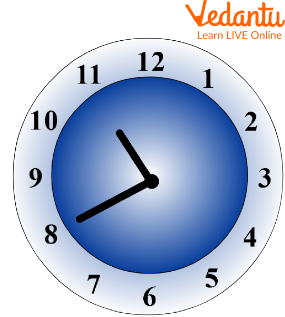
Time
Ans: 10:40
Summary
We saw that the clock has three hands, second, minute, and hour hand. The hour hand indicates an hour. The big hand, i.e. minute hand, indicates the minute, so in whichever number the big hand is pointing, we can calculate the minute with that number. A day has 24 hours. A clock, having markings from 1 to 12, identifies all 24 hours of the day.
It's common to see clocks with Roman Numerals (I, II, III, etc.) and clocks without numbers! Rotating hands surround the clock's face. In the end, we added some practice questions and solved examples to get more clarity on the topic.
FAQs on Different Ways of Reading Time
1. What are AM and PM in time?
AM, also known as Anti-Meridian, and PM, also known as Prime Meridian, are used in the 12-hour clock system to differentiate day and night, respectively. The first 12-hour duration, designated as AM, runs from midnight to noon (12:00 AM to 12:00 PM). The second 12-hour duration, designated as PM, runs from noon to midnight (12:00 PM to 12:00 AM). Therefore, the numbers from 1 to 12 followed by
2. How many numbers do clocks have?
Most modern clocks have the numbers 1 through 12 printed at evenly spaced intervals around the edge of the face, with the number 12 at the top, designating the hour. On many models, sixty dots or lines are also evenly spaced around the dial's perimeter, designating minutes and seconds.
3. Who invented the 24-hour time system?
The 24-hour time system was invented by Hipparchus, who worked between 147 and 127 B.C., proposing dividing the day into 24 equinoctial hours based on the 12 hours of daylight and 12 hours of darkness observed on equinox days.











